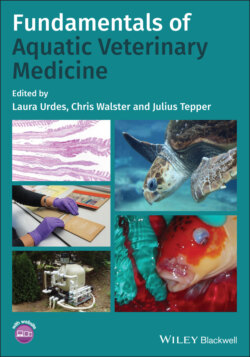Читать книгу Fundamentals of Aquatic Veterinary Medicine - Группа авторов - Страница 32
1.3.2.5 Carbon Dioxide
ОглавлениеCarbon dioxide (CO2) is consumed during photosynthesis by plants and expired during respiration by animals, plants (at night) and bacteria in an aquasystem. When added to pond water by respiration or diffusion, it forms a weak acid (carbonic acid), which lowers the pH. Dissolved oxygen and pH cycles follow the same daily peaks and troughs. Carbon dioxide levels of below 10 mg/l are thought to be well tolerated by fish. While levels greater than 20 ppm often harm fish, especially if dissolved oxygen levels are low, sensitivity to CO2 varies between species. The level of CO2 in source water varies greatly, and is further affected by the respiratory and photosynthetic activity of animals and plants, and the level of decomposition of organic material in that water (a very significant contributor to CO2 levels in some nutrient‐rich waters). CO2 can build up to significantly high levels in systems with large numbers of animals and relatively slow water turnover.
The effect of increased CO2 in water is to reduce the rate at which CO2 from the animal's own metabolism can be released from the blood through the gills. As a result, CO2 in the blood also increases (known as hypercapnia), resulting in a drop in the blood pH and acidosis. At the same time, the oxygen‐carrying ability of the hemoglobin in the blood is reduced. The animal can counteract the effect by balancing the acidosis with an exchange of ions, such as increasing the uptake of bicarbonate and losing hydrogen and phosphate ions and little harm is done. In the long term, this balancing act can have a more profound effect on the health of the animal. Carbon dioxide causes problems in recirculating aquaculture systems without aeration or degassing.
